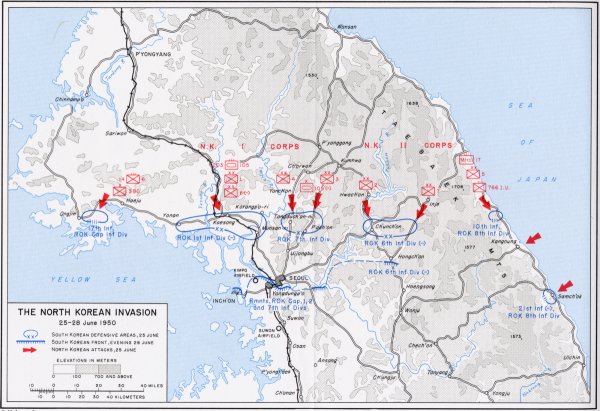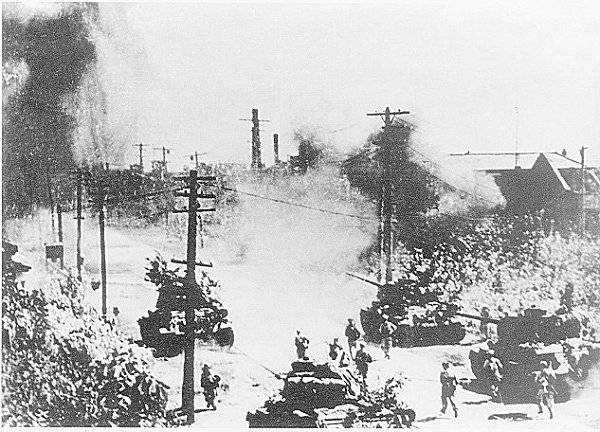On Sunday, 6/25/50, preceded by a long and intensive barrage of artillery and mortar fire, 90,000 Russian -armed North Korean (variously called NK, or NKPA North Korean People's Army, or Inmun Gun) troops launched a coordinated land, sea and air assault against the South. Seven assault infantry divisions smashed headlong into unsuspecting units of the army of the Republic of Korea (ROK). The Inmun Gun were led by over 150 T34/85 tanks, and closely supported by seventeen hundred 122mm howitzers and SU76 self-propelled 76mm guns. Over 200 Russian-supplied YAK ground-attack aircraft gave them total domination of the skies. The ROKs had eight divisions, but only four deployed along the 38th parallel, and they only partially. Much worse, they had no air force, only 2.36 inch rocket launchers, no recoilless rifles, no heavy mortars, no medium artillery ... and no armor. The T34s, arguably the best tanks developed in WWII, advanced in a line-ahead formation. After scores of ROKs died under their treads, trying desperately to stop them with satchel charges and hand grenades, the tanks began moving through the survivors as though they weren't there. At the same time, their infantry formations attacked in an inverted Y formation, sweeping around ROK opposition with the arms, encircling them, and finally crushing them. In two days, Seoul was abandoned to the 1st, 3rd, 4th and 6th Korean People's Army (KPA) divisions, and the KPA 5th division was moving swiftly down east of the rugged Taebaek mountains. In the first week, more than 34,000 ROKs, a third of their army, were killed, captured, or missing.

| North Korea's army consisted of approximately 223,000 troops forming 10 divisions, an armored brigade and support troops:
1st NKPA Infantry Division — 20th, 22nd, and 24th Infantry Regiments
2nd NKPA Infantry Division — 4th, 16th, and 17th Infantry Regiments
3rd NKPA Infantry Division — 7th, 8th, and 9th Infantry Regiments
4th NKPA Infantry Division — 5th, 16th, and 18th Infantry Regiments
5th NKPA Infantry Division — 10th, 11th, and 12th Infantry Regiments
6th NKPA Infantry Division — 13th, 14th, and 15th Infantry Regiments
7th NKPA Infantry Division — 1st, 2nd, and 3rd Infantry Regiments
10th NKPA Infantry Division — 25th, 27th, and 29th Infantry Regiments
13th NKPA Infantry Division — 19th, 21st, and 23rd Infantry Regiments
15th NKPA Infantry Division — 45th, 48th, and 50th Infantry Regiments
105th Armored Brigade — 107th, 109th, and 203rd Armored Regiments
206th Mechanized Infantry Brigade
The armored regiments were equipped with Soviet-made T-34 tanks. Of the infantry divisions, the 1st through 7th Infantry Divisions were "first-line" while the 10th, 13th, and 15th Infantry Divisions were "second-line" or reserve. North Korea used its "first-line" divisions in the attack on South Korea while using the "second-line" units for internal security. Front line strength of the NKPA on 25 June 1950 was approximately 90,000 men. The NKPA was supported by a small North Korean air force and an even smaller navy.
The Republic of Korea became official on 15 August 1948. In late November, the newly-formed ROK National Assembly passed the "Republic of Korea Armed Forces Organization Act" and on 15 December 1948 the ROK Department of National Defense, the ROK Army and ROK Navy became official. At this time, the 1st, 2nd, 3rd, 5th, 6th, and 7th Constabulary Regiments became the 1st, 2nd, 3rd, 5th, 6th, and 7th Republic of Korea Infantry Divisions. Two months later the Capital ROK Infantry Division was formed from the Capital Security Command. Included in the new division was the 1st Cavalry Regiment which was equipped with twenty-four M8 and M20 armored cars plus twelve M3 halftracks. At the same time the 8th and 11th Infantry Divisions were formed from the two remaining constabulary regiments. At this time the total strength of the new army was 65,000 men, with U.S. infantry weapons for only about half this number, the rest being armed with World War Two Japanese weapons. All units were under authorized strength. The ROKs had no tanks and very little artillery, none over 105mm. At the beginning of North Korea's onslaught, only the 1st, 2nd, 6th and 7th Infantry Divisions had three regiments while all the rest had only two regiments, all essentially helpless against the attacking mechanized armies. All divisions were badly mauled during the withdrawal down the Peninsula to the Pusan Perimeter where the 2nd, 5th and 7th Infantry Divisions were disbanded and absorbed into the 1st, 3rd, 6th, 8th, and Capital Infantry Divisions. |
Causes of the Korean Tragedy ... Failure of Leadership, Intelligence and Preparation
The Foundations of Freedom are the Courage of Ordinary People and Quality of our Arms
| |


